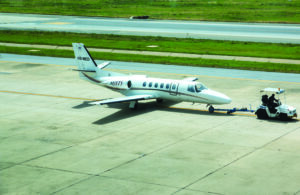In the constantly evolving landscape of the business aviation industry, one thing remains unshakable – that passenger and crew safety is an absolute priority. As aviation safety starts on the ground, internationally recognized standards such as the International Standard for Business Aircraft Handling (IS-BAH) are increasingly being embraced by market players, seeking not only to streamline operations but also to sharpen their competitive edge.
Created in 2014, the IS-BAH is designed to enhance the safety and efficiency of ground handling operations using globally recognized industry best practices.
“Although the program was not set up to establish service standards, which will always be very objective of the users of the services when implemented correctly, the IS-BAH will provide the organization a framework for the management of safety which will lead to overall operational effectiveness,” says Terry Yeomans, director of IS-BAH Program at the International Business Aviation Council (IBAC).
In fact, the IS-BAH was established to ensure that business aviation ground handling has a set of standards and recommended practices tailored to the specific needs of the sector where they differ from the airlines’ needs.
According to Yeomans, this will be helpful as direct regulation by ICAO Member States starts to take effect. Safety issues occasionally come to the fore, especially as some ground service providers (GSPs) embark on cost-cutting initiatives.
“GSPs face significant cost pressures that may, in the long run, undermine their ability to mitigate safety risks,” says Waleed Youssef, director general, ASA World. “Short license durations do not allow ground service providers to adequately recover their capital investments and startup costs, while commercial conditions set by airlines, along with deviations from the IATA Standard Ground Handling Agreement, result in lower financial returns.
“This ultimately results in high staff turnover and may lead to reduced investments in training, equipment, and systems, which can backfire in terms of safety and service quality. This situation is clearly in no one’s best interest, and this spiral must be quickly addressed by all stakeholders.”
A competitive edge

Over the past several years, some FBOs believe that safety certification, as a useful tool, has evolved into a crucial competitive advantage. “When considering the use of FBOs, many global trip support or operators will factor in the certification that the FBO has received, especially if you are new in the market,” says Rita Tam, general manager, TAG Aviation in Macau.
“Most auditors see the IS-BAH certification as the global standard, which will also reduce the vendor selection process.”
In the age of Safety Management Systems, there has been an increased effort for operators to ask questions regarding a service provider’s safety protocol, and ground handling has become part of this effort.
“We have heard around the industry that some operators will only visit service providers with principles or credentials that align with their own,” says Brandon Popovich, NATA’s manager of safety and training. This includes seeking evidence of the NATA member as well as Safety 1st logo on a company’s website. “Pre-trip evaluations of service providers are becoming more frequent around the industry.”
IBAC welcomes the role the IS-BAH is increasingly playing in shaping up the market. “Industry should encourage the positive steps taken voluntarily in adopting the IS-BAH and actively seek those registered organizations when selecting vendors for ground handling services,” Yeomans says.
“Flight safety starts on the ground, the safety-service quality balance needs to be considered in the selection process. Aircraft operators should consider when using third-party vendors to select the service providers being used, what selection criteria are being used, and where safety figures are in that process.”
No pain, no gain
Achieving certification is associated with certain challenges. “One of the biggest hurdles is implementing a Safety Management System, which requires a shift in company culture and a structured approach to risk management,” says Michał Wichrowski, CEO of PMA Aviation, a Warsaw-based GSA.
“Additionally, meeting compliance requirements involves extensive documentation, standardizing procedures, and undergoing regular audits.”
Training is another key challenge ensuring that all employees understand and adhere to IS-BAH standards take time and resources, especially in organizations with high staff turnover, Wichrowski points out. There are also financial considerations, as certification requires investment in training, infrastructure, and ongoing recertification.
For FBOs in some European countries, additional challenges include aligning IS-BAH with local aviation regulations and raising awareness in a market where adoption is still growing, Wichrowski says.
“The absence of a unified certification process poses challenges for GSPs operating in multiple jurisdictions, as they strive for commonality in equipment, processes, and training. We believe that such commonality greatly enhances safety and efficiency,” says Youssef.
Change management can be a challenge for service providers, particularly those with a tenured staff.
“The ‘we’ve always done it this way’ mentality will need to be challenged by both staff and leadership alike,” Popovich says.
Popovich admits that developing and implementing new policies and procedures may increase anxiety within an operation. He suggests that to counter potential unease from changes in policies and procedures and allow for a smooth transition, include the direct input from the frontline staff during the development phase.
“Getting buy-in from frontline staff may also become a simpler task if they are involved from the creation to the deployment of the new procedures. Also, foundational training systems such as the NATA Safety 1st Training Center can play a role in setting a new standard and slowly integrating change into an operation,” he says.
Achieving certification involves a variety of challenges at all levels of the company, from ground handling staff to management departments and all of them must work together, says Jesus Mateu, ground operations and training manager, Luxaviation.
For example, at the management level, this list involves initial financial outlays, investments in GSE, document implementation with detailed Standard Operating Procedures, and integration with other standards such as ICAO, IATA and local regulations. At the same time, FBOs need to face continuously demanding audits, and foster a safety-first culture to all the staff, Mateu emphasizes.
“For the ground handling teams, the challenges are related to the shift to a more standardized safety-conscious mindset, adopting a safety reporting culture, and understanding the importance of continuously training on their wide range of activities,” Mateu says.
Efforts pay off

In addition to providing tangible competitive advantages, the safety certification also promises some tangible results in day-to-day operations.
“The implementation of a robust SMS has helped our organization to identify potential risks on the ramp, monitor safety performance, and enforce protocols for managing hazards,” Mateu says.
In general, the certification aims to have a more proactive, data-driven approach to safety – rather than a reactive one – which means preventing incidents before the risks of their happening occur.
“At the end, when ground handling services are performed with a strong focus on safety and standardized procedures, customers benefit from smoother and more efficient operations, which translates directly to fewer delays, fewer service disruptions, and a greater sense of professionalism,” Mateu says.
“Ground handling involves several safety risks, with some of the most common being aircraft ground collisions, jet blast hazards, foreign object debris, fuel spills, and human fatigue,” says Wichrowski.
“One of the most overlooked aspects of ground handling safety today is worker fatigue and human factors. Long shifts, high-pressure environments, and lack of proper rest contribute to errors and difficulties in finding additional employees, which can lead to serious incidents,” Wichrowski adds.
From the ground incident data IBAC collated over the past 10 years since the IS-BAH program launched, aircraft towing and pushback are among the main casual factors when it comes to aircraft damage events.
“The IS-BAH framework has helped Harrods Aviation to develop protocols and practices that optimize its safety performance whilst contributing to the enhancement of our overall service delivery,” says Dan Holian, director of operations at Harrods Aviation.
“Improvements within incident management have been key in enhancing proactive risk mitigation. In 2024, our overall incident rate reduced by 21%, whilst our hazard reporting went up by 70%, which is a great indication that our safety culture is continuously improving,” Holian adds.
The benefits of improving safety are hard to overestimate. “Reducing incidents enhances customer trust and satisfaction and enables stronger operational efficiency, and so creating a safer environment allows us to improve customer experience,” says Holian.
The team is the core of safety
Although we live in the age of AI, and the aviation sector is no stranger to automation, people remain at the heart of all operations. This means that working with the team remains the key element of any efforts aimed at improving safety.
“Promoting safety culture is a key point for the proper functioning of the safety management system,” says Mateu.
“Everyone must perform their functions and have this safety-first culture integrated, especially ground handling agents who are on the front line. They can help to improve procedures and to be able to take mitigating actions.”
A difficult task

But maintaining safety standards is a rising challenge in the face of increasing staff turnover. “We hear that staff turnover and reducing experience levels is a concern that is rising. Like every aspect of our sector is seeing reduced levels of experience, the days of staff staying with the same organization for 15 years are gone,” says Yeomans.
“Consolidation of facilities continues, and having robust internal processes to deal with the management of those changes can assist with efficiency in the integration between the entities,” he adds.
Due to staffing shortages, training can sometimes seem to be another box checking exercise. Operations staff must balance the critical task of training while servicing a busy ramp says Popovich.
Managing a busy ramp while short on staff may enhance the tendency of ground service providers to skip procedural steps or find a way to complete a task quicker while modifying the procedure.
This scenario could lead to an endless circle of being short-staffed with an increased operational pace and task saturation, leading to increased risk. Some FBOs find it particularly useful to have multiple two-way communication channels with the workers.
“Implementing a mailbox for safety-related issues for everyone and safety committees where each station manager shares experiences are examples of measures that promote a strong safety culture,” says Mateu.
Safety has noticeably improved in the past several years, and one of the tasks for the future is not to lose the hard-won progress. “The challenge is ensuring that the benchmark many have worked hard to establish and implement is not affected by the inevitable commercialisation of safety.
“Safety should be at the core of all operations, we should be able to make money safely, provide that great customer service safely without cutting corners,” says Yeomans.





